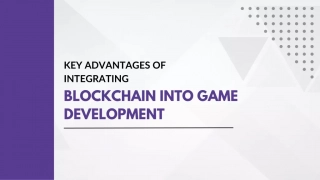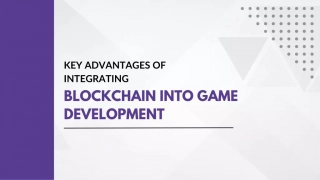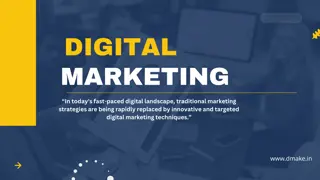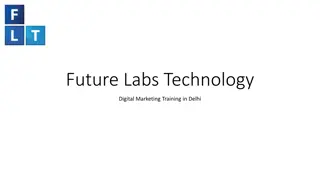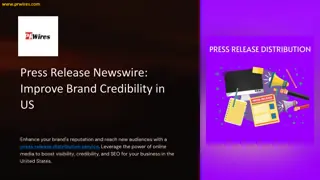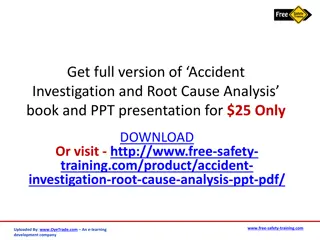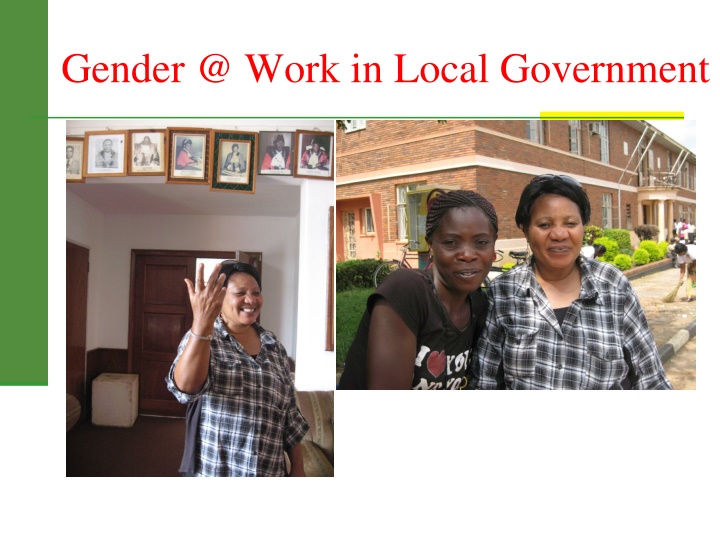
Evolving Gender Mainstreaming in Local Government
Explore the evolution of gender mainstreaming in local government from 2011 to 2018, including methodologies, representation for better policies and services, and the core COE process. Discover the scoring process and next steps for integrating gender into council planning and services.
Download Presentation

Please find below an Image/Link to download the presentation.
The content on the website is provided AS IS for your information and personal use only. It may not be sold, licensed, or shared on other websites without obtaining consent from the author. If you encounter any issues during the download, it is possible that the publisher has removed the file from their server.
You are allowed to download the files provided on this website for personal or commercial use, subject to the condition that they are used lawfully. All files are the property of their respective owners.
The content on the website is provided AS IS for your information and personal use only. It may not be sold, licensed, or shared on other websites without obtaining consent from the author.
E N D
Presentation Transcript
Methodology - Mtintsos framework ACCESS TRANSFORMATION PARTICIPATION Policy Institutional Service delivery Women Individual Men
REPRESENTATION BETTER POLICIES AND SERVICES PARTICIPATION ACCOUNTABILITY TRANSPARENCY RESPONSIVENESS
How gender mainstreaming in local government has evolved over the years 2011 - 2015 10 Stage COE process Action planning IT for advocacy Monitoring & Evaluation Learning and sharing @summits 2015 - 2016 Updating action plans link to Agenda 2030 Baseline scores coding Backstopping of COEs External Assessments of summits 2010 6 stage COE process Action planning Learning and sharing @Summits 2015 - 2016 Sunrise campaign working with GBV survivors in local government 2016 -2018 Roll out COEs take ownership of the Sunrise campaign 50/50 Campaign Summits 2018-2021 SRHR in local government Community dramas on SRHR SRHR campaigns SRHR research SRHR Summits
Core COE Process Original 2010 1 Revised 2011 1 Process Meetings with management and political teams and adoption of COE process. Undertaking a gender audit of the council. Mobilizing meeting with council representatives and popularizing the SADC protocol on Gender and Development. Inception workshop. Action planning workshop 2 3 2 4 4 5 * 3 6 7 8 9 10 Updating of gender action plans in line with the Post-2015 SADC Gender Protocol New baseline scores with colour coding from blue to green to bronze to silver to gold and platinum endorsed by UN Women Quarterly backstopping meetings Annual self and external assessments at the SADC Protocol@Work summit Adoption of the action plan. Media, campaigning skills. IT for advocacy. Monitoring and evaluation Summit * 5 * * 6 Post 2015
Scoring process Green 51-60% Blue Platinum 90% - 100% Gold 80-89% Silver 70-79% Bronze 61-69% Under 50% Entry Level Basic Level Upper Level 3 Upper Level 2 Upper Level 1 Intermediary Level
Next steps: Depth vs breadth Integrating gender into council planning, especially LED. Sunrise Campaign LED/GBV Sharpening Gender Responsive Budgeting GRB Gender disaggregation of council data Gender responsive procurement Gender responsive health facilities Youth friendly SRHR services Youth involvement in local government
Zambia 43 councils have participated in the programme 30 updated Gender Action Plans 10 participated in the Entrepreneurship programme. Focus 10 Councils What do we need to do to revive the work?
Mapping of councils Council Location GAP CLGF/LED Council Sunrise Lusaka Province Post 2015 Pre 2015 yes yes No No Kafue Chongwe Lusaka Province Lusaka Province Post 2015 No Yes Lusaka Lusaka Province Central Province ( 142 Kilometers from Lusaka) Pre 2015 Pre 2015 yes yes No No Rufunsa Kabwe Copperbelt Province (370 Kilometers) Copperbelt Province (300)Kilometers) Luanshya Copperbelt Province (300)Kilometers) Chipata Eastern Province (568 Km from Lusaka) Kasama Northern Province (850 Km from Lusaka) Pre 2015 yes No Kitwe Pre 2015 yes No Ndola Post 2015 yes No Post 2015 yes yes Pre 2015 yes yes
EU Result Area Activities Potential GL Synergies AC grant, LFS Potential synergies CLFG/ GL Joe Cox if approved Capacity assessment 1) Improved leadership, institutional and operational capacities for LA Individual capacity for local leadership and management development Capacity at the organisational level (appt technology for org systems) Peer learning btwn Zambia and European local authorities IDP plans developed and implemented JC women in leadership, 2021 elections; Women in Local Gvt Network Youth junior councils LFS peer learning between Zambian councils Mainstreaming gender into the new IDP plans and budgets 2) Enhanced capacity of local authorities to plan and implement inclusive service delivery and promote LED LED strategies developed and implemented Health sector devolution plan implemented Stakeholder engagement Entrepreneurship programme link to LED SRHR strengthening in local gvt action plans Community Council Scoring Network of Women Entrepreneurs 3) LGAZ capacity to represent and support local gvt in Zambia Knowledge management General public awareness including media SADC Protocol@Work Summit GL extensive work with the media field visits to cover local gvt
GRB Expenditure for the processes gender mainstreaming; Usually less than 1% the budget. Employment-related Average earnings of women and men and efforts to redress this around expenditure: Gender specific project expenditure: This is the proportion of the budget (NOT the proportion of the number of projects!!) that goes to gender specific projects (usually 10 to 20%) Finding gender in mainstream budget expenditure: This is the biggest portion of the budget, and the trickiest area to assess gender impact. This can only be achieved by linking mainstream activities to beneficiary data and analysis. Such analysis shows the extent to which women and men benefit equally from all activities, and if not, why not.
GRB and gender score card Gender process X X Employment Gender specific Gender mainstream I. POLICY FRAMEWORK II. GOVERNANCE III. WORK PLACE POLICY AND PRACTICE IV. LOCAL ECONOMIC DEVELOPMENT V. CLIMATE CHANGE AND SUSTAINABLE DEVELOPMENT VI. INFRASTRUCTURE AND SOCIAL DEVELOPMENT VII. SEXUAL AND REPRODUCTIVE HEALTH, HIV AND AIDS VIII. ENDING VIOLENCE, EMPOWERING WOMEN IX. COMMUNICATIONS AND VISIBILITY X. GENDER MANAGEMENT SYSTEM X X X X X X X X
Junior councils http://genderlinks.org.za/wp- content/uploads/2018/08/A-guide-to-junior- councils-in-Zimbabwe-FINAL.pdf
IDP exercise gender issues 1) Demographic analysis / Stakeholder consultations 2) Settlements and land tenure 3) Poverty and economic analysis 4) Environment and climate change analysis 5) Water and sanitation 6) Solid waste 7) Energy 8) Roads, transport, communication 9) Health 10) Education 11) Community facilities



